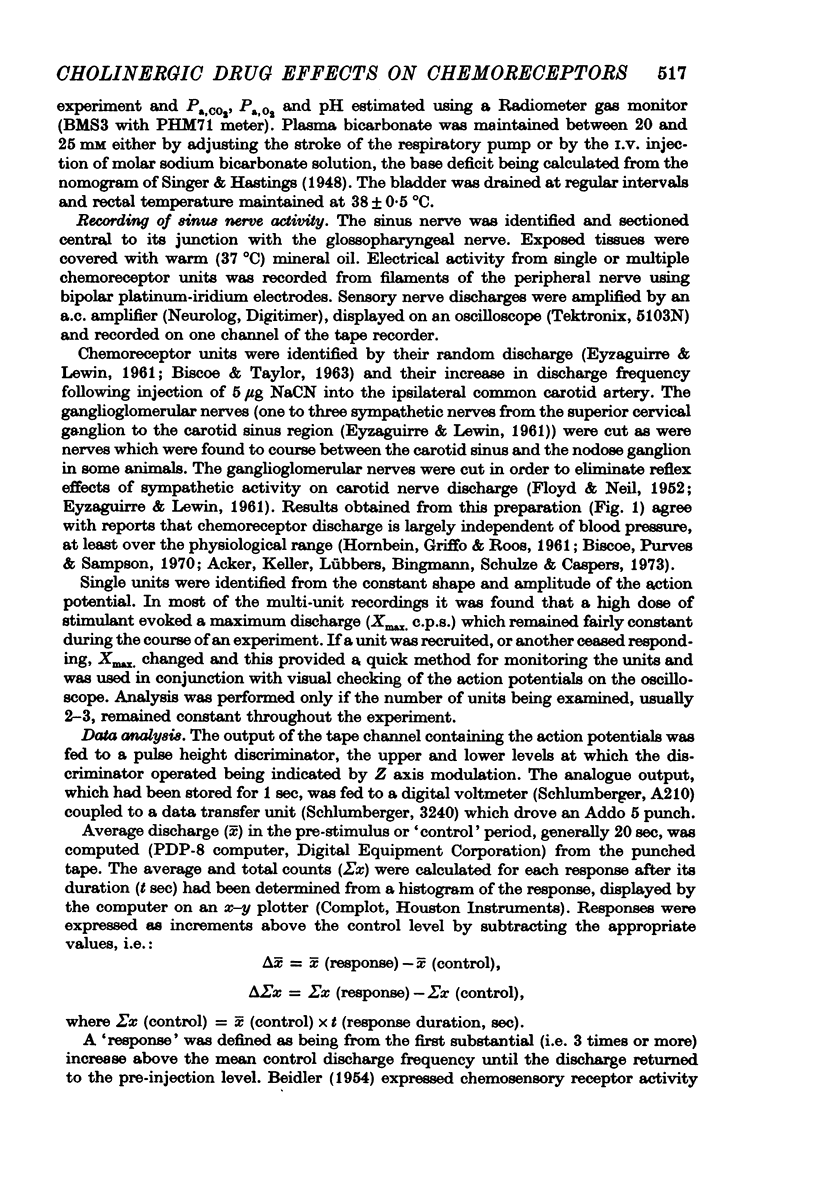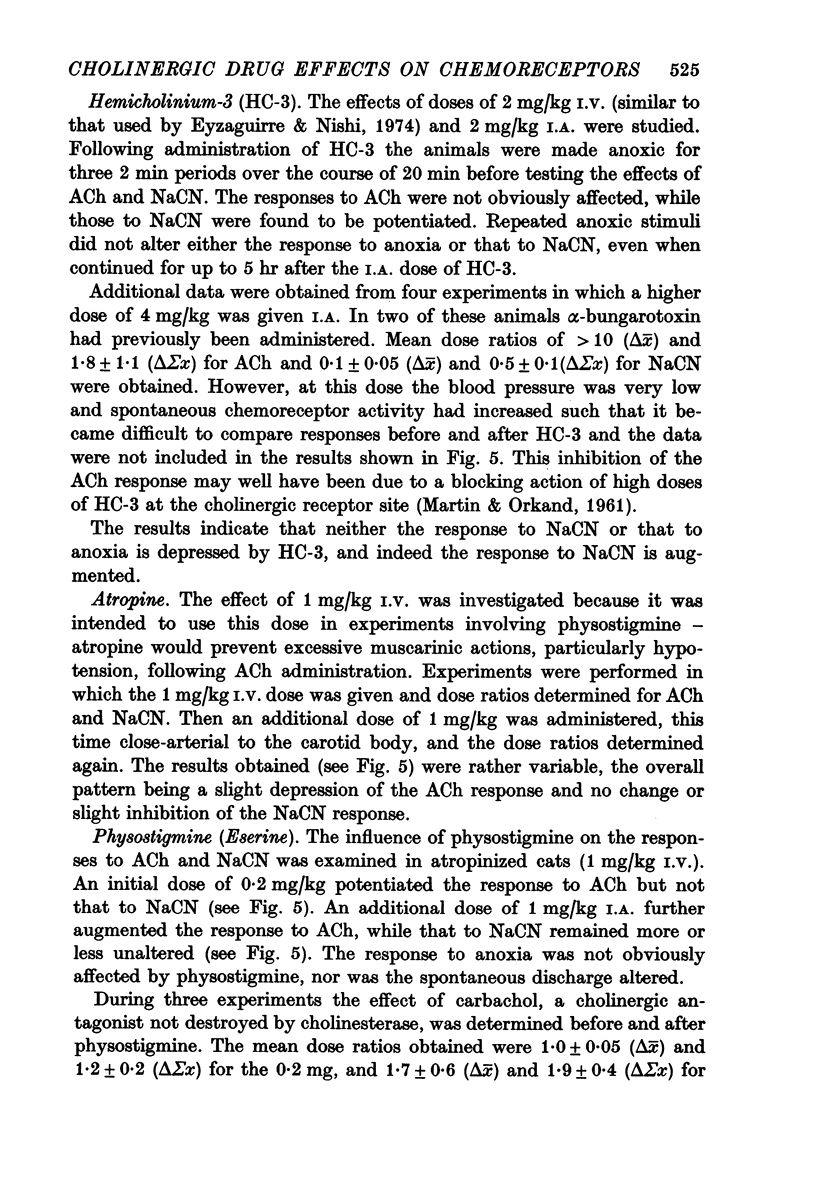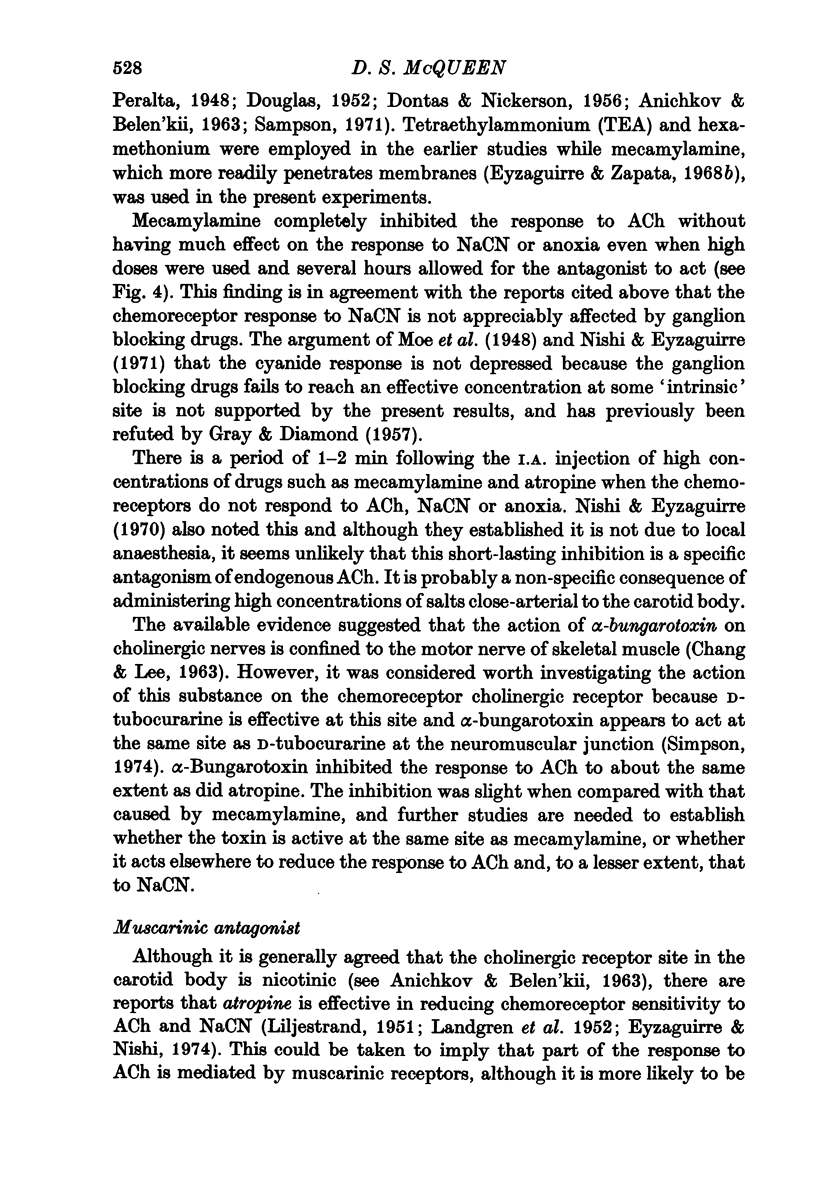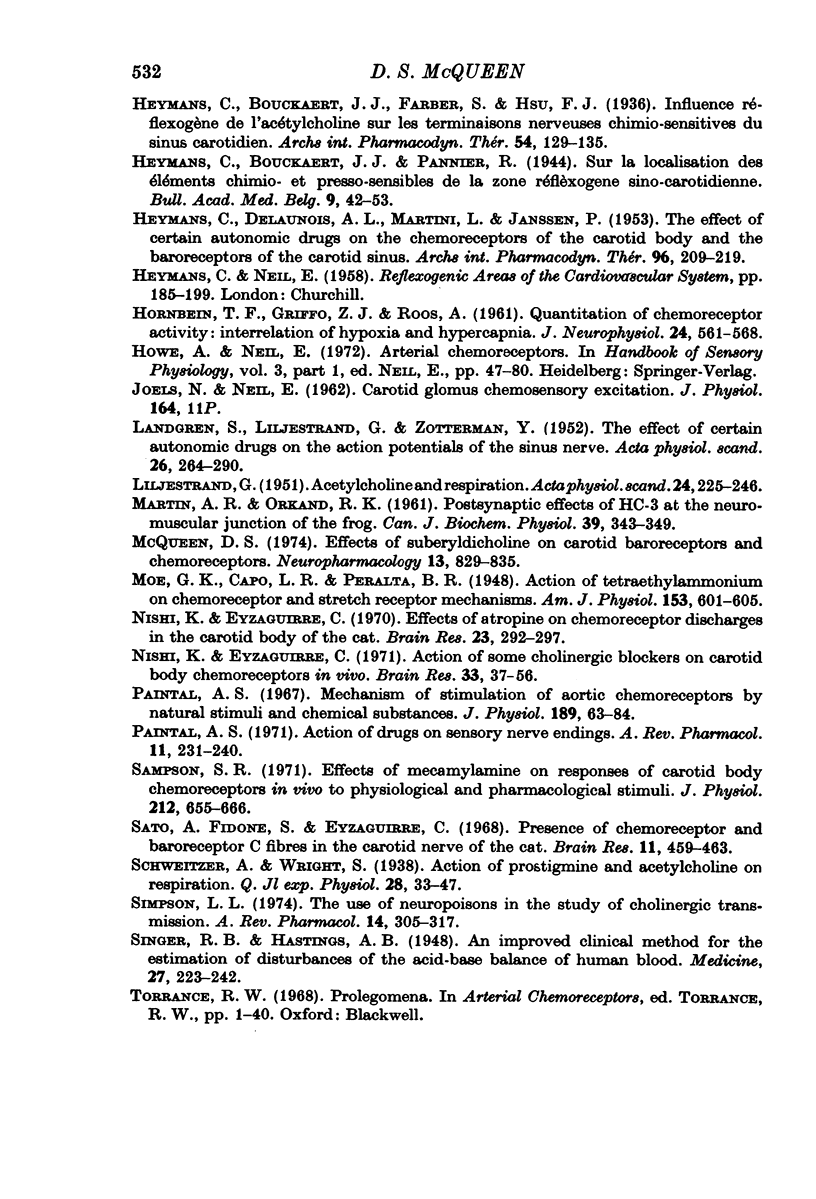Abstract
1. Conflicting qualitative evidence exists concerning the effects on chemoreceptor activity of some drugs which influence the cholinergic system. Quantitative evidence has been obtained in the present study which should resolve the conflict. 2. Experiments were performed in pentobarbitone-anaesthetized cats in which the activity of chemoreceptor units in the sinus nerve was used to assess chemoreceptor responses. The effects of drugs on responses to I.A. ACH and NaCN were determined from dose-response data obtained from several animals and expressed as mean dose ratios 3. The chemoreceptor response to ACh was slightly inhibited by atropine, alpha- and beta-bungarotoxin and HC-3, almost completely suppressed by mecamylamine, and markedly potentiated by physostigmine. 4. Concomitant responses to NaCN were unaffected by atropine, beta-bungarotoxin, mecamylamine or physostigmine. There was a slight inhibition following alpha-bungarotoxin and a potentiation after HC-3. 5. The results do not support the theory that ACh is an excitatory sensory transmitter in the carotid body.
Full text
PDF

















Selected References
These references are in PubMed. This may not be the complete list of references from this article.
- Acker H., Keller H. P., Lübbers D. W., Bingmann D., Schulze H., Caspers H. The relationship between neuronal activity of chemoreceptor fibers and tissue PO2 of the carotid body of the cat during changes in arterial PO2 and blood pressure. Pflugers Arch. 1973 Nov 8;343(4):287–296. doi: 10.1007/BF00595816. [DOI] [PubMed] [Google Scholar]
- BEIDLER L. M. A theory of taste stimulation. J Gen Physiol. 1954 Nov 20;38(2):133–139. doi: 10.1085/jgp.38.2.133. [DOI] [PMC free article] [PubMed] [Google Scholar]
- BISCOE T. J., TAYLOR A. THE DISCHARGE PATTERN RECORDED IN CHEMORECEPTOR AFFERENT FIBRES FROM THE CAT CAROTID BODY WITH NORMAL CIRCULATION AND DURING PERFUSION. J Physiol. 1963 Sep;168:332–344. doi: 10.1113/jphysiol.1963.sp007195. [DOI] [PMC free article] [PubMed] [Google Scholar]
- BYCK R. The effect of hexamethonium on the carotid chemoreceptor response to nicotine and cyanide. Br J Pharmacol Chemother. 1961 Feb;16:15–22. doi: 10.1111/j.1476-5381.1961.tb00293.x. [DOI] [PMC free article] [PubMed] [Google Scholar]
- Biscoe T. J. Carotid body: structure and function. Physiol Rev. 1971 Jul;51(3):437–495. doi: 10.1152/physrev.1971.51.3.437. [DOI] [PubMed] [Google Scholar]
- Biscoe T. J., Purves M. J., Sampson S. R. The frequency of nerve impulses in single carotid body chemoreceptor afferent fibres recorded in vivo with intact circulation. J Physiol. 1970 May;208(1):121–131. doi: 10.1113/jphysiol.1970.sp009109. [DOI] [PMC free article] [PubMed] [Google Scholar]
- Biscoe T. J., Silver A. The distribution of cholinesterases in the cat carotid body. J Physiol. 1966 Mar;183(2):501–512. doi: 10.1113/jphysiol.1966.sp007880. [DOI] [PMC free article] [PubMed] [Google Scholar]
- Chang C. C., Chen T. F., Lee C. Y. Studies of the presynaptic effect of -bungarotoxin on neuromuscular transmission. J Pharmacol Exp Ther. 1973 Feb;184(2):339–345. [PubMed] [Google Scholar]
- DIAMOND J. Observations on the excitation by acetylcholine and by pressure of sensory receptors in the cat's carotid sinus. J Physiol. 1955 Dec 29;130(3):513–532. doi: 10.1113/jphysiol.1955.sp005424. [DOI] [PMC free article] [PubMed] [Google Scholar]
- DONTAS A. S., NICKERSON M. Effects of stimulants and of ganglionic blocking agents on carotid chemoreceptors. Arch Int Pharmacodyn Ther. 1956 May 1;106(3):312–331. [PubMed] [Google Scholar]
- DOUGLAS W. W. Is there chemical transmission at chemoreceptors? Pharmacol Rev. 1954 Mar;6(1):81–83. [PubMed] [Google Scholar]
- DOUGLAS W. W. The effect of a ganglion-blocking drug, hexamethonium, on the response of the cat's carotid body to various stimuli. J Physiol. 1952 Nov;118(3):373–383. doi: 10.1113/jphysiol.1952.sp004801. [DOI] [PMC free article] [PubMed] [Google Scholar]
- EYZAGUIRRE C., LEWIN J. The effect of sympathetic stimulation on carotid nerve activity. J Physiol. 1961 Dec;159:251–267. doi: 10.1113/jphysiol.1961.sp006806. [DOI] [PMC free article] [PubMed] [Google Scholar]
- Eyzaguirre C., Nishi K. Further study on mass receptor potential of carotid body chemosensors. J Neurophysiol. 1974 Jan;37(1):156–169. doi: 10.1152/jn.1974.37.1.156. [DOI] [PubMed] [Google Scholar]
- Eyzaguirre C., Zapata P. The release of acetylcholine from carotid body tissues. Further study on the effects of acetylcholine and cholinergic blocking agents on the chemosensory discharge. J Physiol. 1968 Apr;195(3):589–607. doi: 10.1113/jphysiol.1968.sp008475. [DOI] [PMC free article] [PubMed] [Google Scholar]
- FLOYD W. F., NEIL E. The influence of the sympathetic innervation of the carotid bifurcation on chemoceptor and baroceptor activity in the cat. Arch Int Pharmacodyn Ther. 1952 Sep 1;91(1-2):230–239. [PubMed] [Google Scholar]
- Fidone S. J., Sato A. A study of chemoreceptor and baroreceptor A and C-fibres in the cat carotid nerve. J Physiol. 1969 Dec;205(3):527–548. doi: 10.1113/jphysiol.1969.sp008981. [DOI] [PMC free article] [PubMed] [Google Scholar]
- GRAY J. A., DIAMOND J. Pharmacological properties of sensory receptors and their relation to those of the autonomic nervous system. Br Med Bull. 1957 Sep;13(3):185–188. doi: 10.1093/oxfordjournals.bmb.a069611. [DOI] [PubMed] [Google Scholar]
- HEYMANS C. Action of drugs on carotid body and sinus. Pharmacol Rev. 1955 Mar;7(1):119–142. [PubMed] [Google Scholar]
- HEYMANS C., DELAUNOIS A. L., MARTINI L., JANSSEN P. The effect of certain autonomic drugs on the chemoreceptors of the carotid body and the baroreceptors of the carotid sinus. Arch Int Pharmacodyn Ther. 1953 Nov 1;96(2):209–219. [PubMed] [Google Scholar]
- HORNBEIN T. F., GRIFFO Z. J., ROOS A. Quantitation of chemoreceptor activity: interrelation of hypoxia and hypercapnia. J Neurophysiol. 1961 Nov;24:561–568. doi: 10.1152/jn.1961.24.6.561. [DOI] [PubMed] [Google Scholar]
- MARTIN A. R., ORKAND R. K. Postsynaptic effects of HC-3 at the neuromuscular junction of the frog. Can J Biochem Physiol. 1961 Feb;39:343–349. doi: 10.1139/o61-034. [DOI] [PubMed] [Google Scholar]
- McQueen D. S. Effects of suberyldicholine on carotid baroreceptors and chemoreceptors. Neuropharmacology. 1974 Sep;13(9):829–835. doi: 10.1016/0028-3908(74)90038-0. [DOI] [PubMed] [Google Scholar]
- Nishi K., Eyzaguirre C. Effects of atropine on chemoreceptor discharges in the carotid body of the cat. Brain Res. 1970 Oct 13;23(2):292–297. doi: 10.1016/0006-8993(70)90055-7. [DOI] [PubMed] [Google Scholar]
- Nishi K., Eyzaguirre C. The action of some cholinergic blockers on carotid body chemoreceptors in vivo. Brain Res. 1971 Oct 8;33(1):37–56. doi: 10.1016/0006-8993(71)90304-0. [DOI] [PubMed] [Google Scholar]
- Paintal A. S. Mechanism of stimulation of aortic chemoreceptors by natural stimuli and chemical substances. J Physiol. 1967 Mar;189(1):63–84. doi: 10.1113/jphysiol.1967.sp008155. [DOI] [PMC free article] [PubMed] [Google Scholar]
- Sampson S. R. Effects of mecamylamine on responses of carotid body chemoreceptors in vivo to physiological and pharmacological stimuli. J Physiol. 1971 Feb;212(3):655–666. doi: 10.1113/jphysiol.1971.sp009348. [DOI] [PMC free article] [PubMed] [Google Scholar]
- Sato A., Fidone S., Eyzaguirre C. Presence of chemoreceptor and baroreceptor C-fibers in the carotid nerve of the cat. Brain Res. 1968 Nov;11(2):459–463. doi: 10.1016/0006-8993(68)90041-3. [DOI] [PubMed] [Google Scholar]


